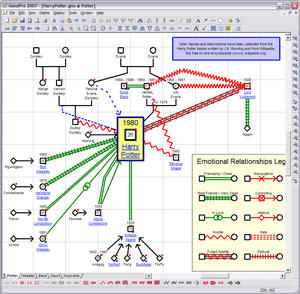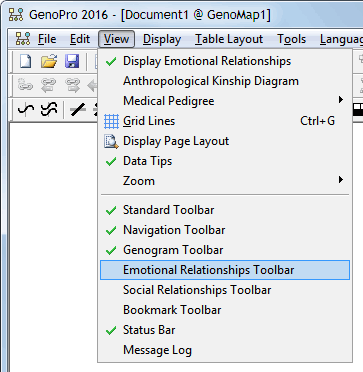Emotional Relationships in genograms
Family relationships may be used to describe the emotional bond
between people involved in a union, but the emotional relationship component is used to describe the
emotional bond between any two individuals in the genogram (family tree).
GenoPro allows you
to choose among a wide selection of emotional relationship categories. The selection will be displayed on the
genogram with its corresponding color-coded link. With a few clicks, you can easily assess the level of cohesiveness
within a family or a group. GenoPro defines 34 types of emotional relationships:
 Emotional Relationships Key
Emotional Relationships Key
 Emotional Relationships Sample
Emotional Relationships Sample
Each type of emotional relationship is described in the table below. The symbols have been enlarged for better viewing.
Defines a plain normal relationship. This emotional relationship may serve the purpose of highlighting a normal
relationship among numerous dysfunctional relationships. It may resemble the identical twins
link, but the line for twins is gray. Twins are also connected to each other through a child link that
looks like an inverted V. If a plain normal relationship needs to be displayed, then create a non-linear line
between the twins.
Defines an apathetic relationship where one or both individuals are indifferent to the other.
Defines a distant relationship between two individuals. Communication is very limited, usually due to differences in lifestyles.
Defines a cutoff relationship where two individuals have no contact at all, characterized by extreme disengagement
and emotional intensity where there had formerly been love, affection, or friendliness.
Defines a relationship in which at least one of the individuals perceives the relationship to be negative and
where both individuals are convinced they are right.
Defines a relationship of intense enmity or antipathy in which the individuals wish harm upon each other and take
pleasure in each other's misery.
Defines a good relationship between two individuals in which there is mutual respect.
Defines a close relationship (friendship) between two individuals in which they share affection or esteem and
engage in mutually helping behaviors.
Defines a relationship of deep friendship, where two individuals share a deeper level of understanding,
trust and affection than with most other friends.
Defines a relationship of strong positive affection between two individuals, arising from kinship
or recognition of attractive qualities.
Defines a relationship of intimacy, passion and commitment based on sexual instinct.
Defines a relationship of distrust between two individuals where at least one of the individuals lacks confidence in the other's intentions.
Defines a fused relationship between two individuals. Individuals become dependant on one another, and also become
inseperable, with little room for their own identities.
Defines a hostile relationship between two individuals where the individuals argue on major issues and feel
heightened stress and aggression when they are together.
Defines a distant-hostile relationship between two individuals. The two individuals rarely come into contact,
but when they are in each other's presence, they argue and are hostile towards one another.
Defines a close-hostile relationship between two individuals. These people often come into contact, but they
argue and keep secrets from one another.
Defines a fused-hostile relationship between two individuals. These individuals are always together and
depend on each other, yet they are unable to live without arguing.
Defines a violent relationship between two individuals. The two individuals often come into conflict when
they meet which results in extreme actions such as physical force or excessive power.
Defines a relationship in which the two individuals rarely see each other, but when they come together, they
argue and engage in violent behavior.
Defines a relationship in which two individuals often come into contact, but they argue and are engaged in
violent behavior when they are together.
Defines a violent behavior in an fused relationship. Violence takes place to avoid a break in the relationship,
especially when intimacy/fusion is difficult or impossible to maintain. Fusion compromises the feelings, identities
and self-direction of each, thus creating true instability.
Defines an abusive relationship. This is a generic relationship for situations in which an undertermined type of
abuse occurs between two individuals.
Defines a relationship in which one individual physically abuses another. It includes any non-accidental injury
to an individual, typically to a child or a woman. This includes hitting, kicking, slapping, shaking, burning,
pinching, hair pulling, biting, choking, throwing, shoving, whipping, and paddling.
Defines a relationship in which one individual emotionally abuses another. It includes any attitude or behavior
which interferes with mental health or social development. This includes yelling, screaming, name-calling, shaming,
negative comparisons to others, telling them they are "bad, no good, worthless" or "a mistake".
Defines a relationship in which one individual sexually abuses another. It includes any sexual act between an
adult and child, or a forced sexual action between two adults. This includes fondling, penetration, intercourse,
exploitation, pornography, exhibitionism, child prostitution, group sex, oral sex, or forced observation of sexual acts.
Defines a relationship in which an individual fails to provide for a dependant's physical needs. This includes
lack of supervision, inappropriate housing or shelter, inadequate provision of food, inappropriate clothing for
season or weather, abandonment, denial of medical care, and inadequate hygiene.
Defines a relationship in which one individual manipulates another individual.
Defines a relationship in which one individual controls another individual.
Defines a relationship in which one individual feels resentment against someone because of that person's rivalry,
success, or advantages.
Defines a relationship in which one individual has an unhealthy focus (obsession) on another individual.
This may include favoritism and stalking.
Defines a relationship in which one individual is an ardent admirer of another, and has an intense, occasionally
overwhelming liking of that person.
Defines a relationship in which one individual has intense feelings of interest towards another individual, with
an acute longing for reciprocation.
Defines a relationship in which two individuals have never met. This relationship is used to explicitly
confirm that two individuals such as an adopted child and his biological parents have never been in contact.
As the creator of the genogram, you may add more details regarding the relationship, such as 'never met
physically' but 'met online'.
Defines any emotional relationship that is not defined in the list. Use a comment to elaborate on the details of
this particular relationship.
The content of this page, including the symbols, may be copied without any request for permission.
We have created a printable Acrobat PDF file that includes the list of Genogram symbols that you can download
and print if you wish to have a quick reference. You can download the file by clicking on the thumb at the left or
here.
To display the toolbar, click on the View menu and select the menu
item Emotional Relationships Toolbar.

Previous: Family Relationships in Genograms
Next: Medical Genograms